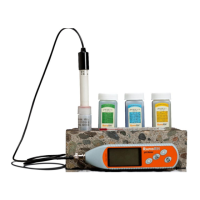pH is a measurement of the acidity or basicity of an aqueous solution.
When pH is 7.0, the aqueous solution is said to be neutral; solutions with
a pH less than 7.0 are said to be acidic (the lower the number [i.e. 2.4],
the more acidic) and solutions with a pH greater than 7.0 are referred to
as alkaline (the higher the reading above 7.0, the more alkaline). pH is
represented on a scale of 0 – 14, with 0 being the highest level of acidity,
and 14 being the highest level of alkalinity. Understanding the pH of a
solution can help gauge the ways in which it will interact with other
substances introduced to the solution, or that the solution will come in
contact with.
NOTE: Prior to initial usage, you should do a three-point calibration.
(i.e., repeat below steps with all three buffer solutions [4.0, 7.0, and
10.01]. Below steps should be followed prior to each usage.)
A. Use the thermometer to measure the temperature of the 7.0 pH buffer
solution.
B. Press the button to turn on the Rapid RH
®
Portable pH Meter.
C. Press the Up arrow or the Down arrow to manually
adjust the temperature on the LCD screen to match the temperature
of the 7.0 buffer solution, taken in step A, with the thermometer.
D. Open the cover of the pH socket and connect the electrode to the pH
meter.
E. Place the pH electrode into distilled water, wash it, and then allow the
probe to air dry or gently blot it dry. The electrode must also be rinsed
and dried between each sample reading.
F. Place the pH electrode into the pH 7.00 buffer solution, stir gently, and
then hold the electrode stationary in the buffer solution. After the pH
value is stabilized, press the calibration button until the LCD
screen displays. Release the calibration button. The LCD screen will

